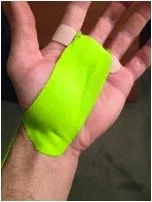Different Uses of Kinesiology Tape
I cut my hand de-pitting an avocado. The combination of a sharp knife and a slippery fruit lead to this silly mistake. The price of eating healthy ;-).
The laceration was rather deep in the palm of my left hand, between my second and third digits.
Upon removing the blade, blood seeped out in a rather stream like fashion, therefore I used gauze and a bandage as a way to protect my hand. Finding this to be cumbersome and inefficient, as soon as the bleeding stopped and the cut started to seal up (about 24 hours), I decided to see what my skills with kinesiology tape could do. (I also couldn’t get to any tape sooner).
I started with the lymphatic drainage tape strips on the back of my arm using the Muscle Vector Taping© technique (Pic 1 and 2). This would help the swelling that occurred from the injury and help support my wrist muscles as I still had to work. (Swelling reduced 80% in one day).
I then cut a small slit for my finger and placed the kinesiology tape OVER a bandage that was over the wound (never put kinesiology tape over an open wound) – pic 3.
This tape job was waterproof and allowed me to work with my hands. The lymphatic drainage actually supported my wrist a lot more and allowed me to grab things with my fingers more freely. It also allowed me to start doing some rehab to retrain the muscles that were damaged.
Highly recommend this durable waterproof tape even in silly mistakes that cause deep cuts.
“Full of Life!” – Konrad Grzeszkowiak, DC


